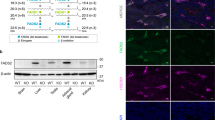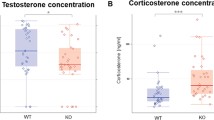Abstract
Rat HDL are known to increase testosterone production by cultured Leydig cells either following gonadotropin stimulation or cholesteryl ester depletion. However, rat HDL contain apolipoprotein E and have a high affinity for the members of the low density receptor family such as LDL receptor, LDL receptor related protein and VLDL receptor. In contrast with the adrenal cells, the contribution of apo A-I and apo E pathways in HDL cholesterol uptake has not been yet evidenced in rat Leydig cells. Recent data provided evidence that hCG stimulates scavenger receptor BI expression in testes. In order to investigate if testosterone production can be stimulated by apo E depleted HDL, we compared the level of testosterone stimulation by HDL with or without apo E first, in presence of saturating dose of hCG (1 IU/ml) and second, after depletion of cholesterol synthesis by pravastatin, an inhibitor of HMG-CoA reductase. In presence of hCG, HDL with or without apo E increased testosterone production respectively by 37 and 25%. Pravastatin at 100 μg/ml inhibited the cholesterol synthesis and the testosterone production by 25% and decreased the cholesteryl content by 25%. The addition of HDL with or without apo E (50 μg protein HDL/ml) completely overcame the depletion of cellular cholesteryl esters and the inhibition of testosterone production induced by pravastatin. In the presence of heparin, apo E depleted HDL overcame the testosterone production induced by pravastatin, indicating that uptake of HDL without apo E via a secretion of apo E by the cells themselves was not involved. Therefore, in absence of apo E, it is suggested that rat Leydig cells used HDL to regulate steroidogenesis via an apolipoprotein A-I pathway.
Similar content being viewed by others
References
Brown MS, Goldstein JL: Receptor-mediated control of cholesterol metabolism. Science 191: 150-154, 1976
Brown MS, Ho YK, Goldstein JL: The cholesteryl ester cycle in macrophage foam cells. Continual hydrolysis and re-esterification of cytoplasmic cholesteryl esters. J Biol Chem 255: 9344-9352, 1980
Azhar S, Menon KMJ: Receptor mediated gonadotropin action in gonadal tissues: relationship between blood cholesterol levels and gonadotropin stimulated steroidogenesis in isolated rat Leydig and luteal cells. J Steroid Biochem 16: 175-184, 1982
Le Goff D: Follicular fluid lipoproteins in the mare: Evaluation of HDL transfer from plasma to follicular fluid. Biochim Biophys Acta 1210: 226-232, 1994
Maboundou JC, Fofana M, Fresnel J, Bocquet J, Le Goff D: Effect of lipoproteins in rat Sertoli cells. Biochem Cell Biol 73: 67-72, 1995
Fofana M, Maboundou JC, Bocquet J, Le Goff D: Transfer of cholesterol between high density lipoproteins and cultured rat Sertoli cells. Biochem Cell Biol 74: 681-686, 1996
Morris MD, Chaikoff IL: The origin of cholesterol in liver, small intestine, adrenal gland and testis of the rat: Dietary vs. endogenous contributions. J Biol Chem 234: 1095-1097, 1958
Rajan VP, Menon KMJ: Cholesterol flux between high density lipoproteins and cultured rat luteal cells. Endocrinology 124: 1857-1862, 1989
Yokoyama S: Apolipoprotein-mediated cellular cholesterol efflux. Biochim Biophys Acta 1392: 1-15, 1998
Rigotti A, Trigatti BL, Penman M, Rayburn H, Herz J, Krieger M: A targeted mutation in the murine gene encoding the high density lipoprotein (HDL) receptor scavenger receptor class B type I reveals its key role in HDL metabolism. Proc Natl Acad Sci USA 94: 12610-12615, 1997
Landschultz KT, Pathak RK, Rigotti A, Krieger M, Hobbs HH: Regulation of scavenger receptor, class B, type I, a high density lipoprotein receptor, in liver and steroidogenic tissues of the rat. J Clin Invest 98: 984-995, 1996
Temel RE, Trigatti B, DeMattos RB, Azhar S, Krieger M, Williams DL: Scavenger receptor class B, type I (SR-BI) is the major route for the delivery of high density lipoprotein cholesterol to the steroidogenic pathway in cultured mouse adrenocortical cells. Proc Natl Acad Sci USA 94: 13600-13605, 1997
Mayerhofer A, Hikim APS, Bartke A, Russell LD: Changes in the testicular microvasculature during photoperiod-related seasonal transition from reproductive quiescence to reproductive activity in the adult golden hamster. Anat Rec 224: 495-507, 1989
Koelz HR, Sherrill BC, Turley SD, Dietschy JM: Correlation of low and high density lipoprotein binding in vivo with rates of lipoprotein degradation in the rat. J Biol Chem 257: 8061-8072, 1982
Osono Y, Woollett LA, Herz J, Dietschy JM: Role of the low density lipoprotein receptor in the flux of cholesterol through the plasma and across the tissues of the mouse. J Clin Invest 95: 1124-1132, 1995
Quinn PG, Dombrausky LJ, Chen YD, Payne AH: Serum lipoproteins increase testosterone production in hCG-desensitized Leydig cells. Endocrinology 109: 1790-1792, 1981
Schreiber JR, Weinstein DB, Hsueh AJW: Lipoproteins stimulate androgen production by cultured rat testis cells. J Steroid Biochem 16: 39-43, 1982
Hou JW, Collins DC, Schleicher RL: Sources of cholesterol for testosterone biosynthesis in murine Leydig cells. Endocrinology 127: 2047-2055, 1990
Risbridger GP, Hedger MP: Adult rat Leydig cell cultures: Minimum requirements for maintenance of luteinizing hormone responsiveness and testosterone production. Mol Cell Endo 83: 125-132, 1992
Chapman MJ, Goldstein S, Lagrange D, Laplaud PM: A density gradient ultracentrifugal procedure for the isolation of the major lipoprotein classes from human serum. J Lipid Res 22: 339-358, 1981
Salè FO, Marchesini S, Fishman PH, Berra B: A sensitive enzymatic assay for determination of cholesterol in lipid extracts. Anal Biochem 42: 347-350, 1984
Smith PK, Krohn RI, Hermanson GT, Mallia AK, Gartner FH, Provenzano MD, Fujimoto EK, Goeke NM, Olson BJ, Klenk DC: Measurement of protein using bicinchoninic acid. Anal Biochem 150: 76-85, 1985
Dyer CA, Curtiss LK: Apoprotein E-rich high density lipoproteins inhibit ovarian androgen synthesis. J Biol Chem 263: 10965-10973, 1988
Papadopoulos V, Carreau S, Drosdowsky MA: Effects of phorbol ester and phospholipase C on LH-stimulated steroidogenesis in purified rat Leydig cells. FEBS Lett 188: 312-316, 1985
Aldred LF, Cooke BA: The effect of cell damage on the density and steroidogenic capacity of rat testis Leydig cells, using an NADH exclusion test for determination of viability. J Steroid Biochem 18: 411-414, 1983
Hara A, Radin NS: Lipid extraction of tissues with a low-toxicity solvent. Anal Biochem 90: 420-426, 1978
Zorich NL, Kézdy KE, Jonas A: Properties of discoidal complexes of human apolipoprotein A-I with phosphatidylcholines containing various fatty acid chains. Biochim Biophys Acta 919: 181-189, 1987
DeLamatre JG, Sarphie TG, Archibold RC, Hornick CA: Metabolism of apo E-free high density lipoproteins in rat hepatoma cells: Evidence for a retroendocytic pathway. J Lipid Res 31: 191-202, 1990
Hedger MP, Risbridger GP: Effect of serum and serum lipoproteins on testosterone production by adult rat leydig cells in vitro. J Steroid Biochem Mol Biol 43: 581-589, 1992
Johnson WJ, Mahlberg FH, Rothblat GH, Philipps MC: Cholesterol transport between cells and high-density lipoproteins. Biochim Biophys Acta 1085: 273-298, 1991
Oram JF, Yokoyama S: Apolipoprotein-mediated removal of cellular cholesterol and phospholipids. J Lipid Res 37: 2473-2491, 1996
Dvorin E, Gorder NL, Benson DM, Gotto AM: Apolipoprotein A-IV: A determinant for binding and uptake of high density lipoproteins by rat hepatocytes. J Biol Chem 261: 15714-15718, 1986
Rajan VP, Menon KMJ: Differential uptake and metabolism of free and esterified cholesterol from high-density lipoproteins in the ovary. Biochim Biophys Acta 959: 206-213, 1988
Wang N, Weng W, Breslow JL, Tall AR: Scavenger receptor BI (SRBI) is up-regulated in adrenal gland in apolipoprotein A-I and hepatic lipase knock-out mice as a response to depletion of cholesterol stores. J Biol Chem 271: 21001-21004, 1996
Endo A: The discovery and development of HMG-CoA reductase inhibitors. J Lipid Res 33: 1569-1582, 1992
Van Vliet AK, van Thiel GCF, Huisman RH, Moshage H, Yap SH, Cohen LH: Different effects of 3-hydroxy-3-methylglutaryl-coenzyme A reductase inhibitors on sterol synthesis in various human cell types. Biochim Biophys Acta 1254: 105-111, 1995
Lennernäs H, Fager G: Pharmacodynamics and pharmacokinetics of the HMG-CoA reductase inhibitors. Clin Pharmacokinet 32: 403-425, 1997
Van Vliet AK, van Thiel GCF, Naaktgeboren N, Cohen LH: Vastatins have a distinct effect on sterol synthesis and progesterone secretion in human granulosa cells in vitro. Biochim Biophys Acta 1301: 237-241, 1996
Arai T, Rinninger F, Varban L, Fairchild-Huntress V, Liang CP, Chen W, Seo T, Deckelbaum R, Huszar D, Tall AR: Decreased selective uptake of high density lipoprotein cholesteryl esters in apolipoprotein E knock-out mice. Proc Natl Acad Sci USA 96: 12050-12055, 1999
Author information
Authors and Affiliations
Rights and permissions
About this article
Cite this article
Travert, C., Forfana, M., Carreau, S. et al. Rat Leydig cells use apolipoprotein E depleted high density lipoprotein to regulate testosterone production. Mol Cell Biochem 213, 51–59 (2000). https://doi.org/10.1023/A:1007178532236
Issue Date:
DOI: https://doi.org/10.1023/A:1007178532236




